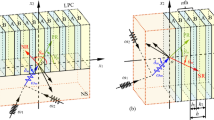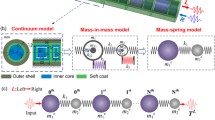Abstract
This investigation is focused on the nonreciprocal transmission of the non-collinear mixing wave in a nonlinear elastic wave metamaterial. The nonlinear elastic wave metamaterial with asymmetric structure is used to break the traditional reciprocal transmission, which is composed of a nonlinear material and a linear phononic crystal. When two non-collinear shear waves following the resonant condition interact with each other, the sum frequency longitudinal wave can be generated and propagate together with fundamental and second harmonics. Based on the transfer and stiffness matrices, band gaps and transmission coefficients are derived. The changing of band structures results in manipulating elastic waves with different frequencies. In the nonreciprocal frequency region, elastic waves can propagate along the positive direction while the reverse case is prohibited. The mixing of two incident SV waves in the nonlinear elastic wave metamaterial is verified by experiments and the results can support the theoretical analysis and numerical calculations. Because of material nonlinearity and asymmetric structure, the nonlinear elastic wave metamaterial can behave as a mechanical diode. The present work shows the possibility to design nonreciprocal elastic wave device by nonlinear wave mixing methods.














Similar content being viewed by others
References
Madeo, A., Collet, M., Miniaci, M., Billon, K., Ouisse, M., Neff, P.: Modeling phononic crystals via the weighted relaxed micromorphic model with free and gradient micro-inertia. J. Elast. 130, 59–83 (2018)
Aghighi, F., Morris, J., Amirkhizi, A.V.: Low-frequency micro-structured mechanical metamaterials. Mech. Mater. 130, 65–75 (2019)
Li, Z.W., Wang, C., Wang, X.D.: Modelling of elastic metamaterials with negative mass and modulus based on translational resonance. Int. J. Solids Struct. 162, 271–284 (2019)
Goldsberry, B.M., Wallen, S.P., Guyomar, D., Haberman, M.R.: Non-reciprocal wave propagation in mechanically-modulated continuous elastic metamaterials. J. Acoust. Soc. Am. 146, 782–788 (2019)
Colbrook, M.J., Kisil, A.V.: A Mathieu function boundary spectral method for scattering by multiple variable poro-elastic plates, with applications to metamaterials and acoustics. Proc. R. Soc. A 479, 20200184 (2020)
Witarto, W., Nakshatrala, K.B., Mo, Y.L.: Global sensitivity analysis of frequency band gaps in one-dimensional phononic crystals. Mech. Mater. 134, 38–53 (2019)
Yuksel, O., Yilmaz, C.: Realization of an ultrawide stop band in a 2-D elastic metamaterial with topologically optimized inertial amplification mechanisms. Int. J. Solids Struct. 203, 138–150 (2020)
Melnikov, A., Maeder, M., Friedrich, N., Pozhanka, Y., Wollmann, A., Scheffler, M., Oberst, S., Powell, D., Marburg, S.: Acoustic metamaterial capsule for reduction of stage machinery noise. J. Acoust. Soc. Am. 147, 1491–1503 (2020)
Nguyen, H.Q., Wu, Q., Chen, H., Chen, J.J., Yu, Y.K., Tracy, S., Huang, G.L.: A Fano-based acoustic metamaterial for ultra-broadband sound barriers. Proc. R. Soc. A 477, 20210024 (2021)
Kerrian, P.A., Hanford, A.D., Capone, D.E., Beck, B.S.: Development of a perforated plate underwater acoustic ground cloak. J. Acoust. Soc. Am. 146, 2303–2308 (2019)
Deng, Y.J., Li, H.J., Liu, H.Y.: Spectral properties of Neumann–Poincare operator and anomalous localized resonance in elasticity beyond quasi-static limit. J. Elast. 140, 213–242 (2020)
Mokhtari, A.A., Lu, Y., Srivastava, A.: On the emergence of negative effective density and modulus in 2-phase phononic crystals. J. Mech. Phys. Solids 126, 256–271 (2019)
Fu, C.Y., Wang, B.H., Zhao, T.F., Chen, C.Q.: High efficiency and broadband acoustic diodes. Appl. Phys. Lett. 112, 051902 (2018)
Gliozzi, A.S., Miniaci, M., Krushynska, A.O., Morvan, B., Scalerandi, M., Pugno, N.M., Bosia, F.: Proof of concept of a frequency-preserving and time-invariant metamaterial-based nonlinear acoustic diode. Sci. Rep. 9, 9560 (2019)
Zhao, J.L., Chillara, V.K., Ren, B.Y., Cho, H.J., Qiu, J.H., Lissenden, C.J.: Second harmonic generation in composites: theoretical and numerical analyses. J. Appl. Phys. 119, 064902 (2016)
Ishii, Y., Biwa, S., Adachi, T.: Second-harmonic generation of two-dimensional elastic wave propagation in an infinite layered structure with nonlinear spring-type interfaces. Wave Motion 96, 102569 (2020)
Zhao, Y.X., Chen, Z.M., Cao, P., Qiu, Y.J.: Experiment and FEM study of one-way mixing of elastic waves with quadratic nonlinearity. Nondestruct. Test. Eval. Int. 72, 33–40 (2015)
Delgadillo, H.H., Loendersloot, R., Yntema, D., Tinga, T., Akkerman, R.: Steering the propagation direction of a non-linear acoustic wave in a solid material. Ultrasonics 98, 28–34 (2019)
Tang, G.X., Liu, M.H., Jacobs, L.J., Qu, J.M.: Detecting localized plastic strain by a scanning collinear wave mixing method. J. Nondestruct. Eval. 33, 196–204 (2014)
Ju, T.H., Achenbach, J.D., Jacobs, L.J., Guimaraes, M., Qu, J.M.: Ultrasonic nondestructive evaluation of alkali–silica reaction damage in concrete prism samples. Mater. Struct. 50, 60 (2017)
Zhao, Y.X., Xu, Y.M., Chen, Z.M., Cao, P., Hu, N.: Detection and characterization of randomly distributed micro-cracks in elastic solids by one-way collinear mixing method. J. Nondestruct. Eval. 37, 47 (2018)
Cui, J.G., Yang, T.Z., Chen, L.Q.: Frequency-preserved non-reciprocal acoustic propagation in a granular chain. Appl. Phys. Lett. 112, 181904 (2018)
Devaux, T., Cebrecos, A., Richoux, O., Pagneux, V., Tournat, V.: Acoustic radiation pressure for nonreciprocal transmission and switch effects. Nat. Commun. 10, 3292 (2019)
Zakeri, M., Keller, S.M., Wang, Y.E., Lynch, C.S.: Nonreciprocal wave propagation and parametric amplification of bulk elastic waves in nonlinear anisotropic materials. New J. Phys. 22, 023009 (2020)
Baz, A.: Active synthesis of a gyroscopic-nonreciprocal acoustic metamaterial. J. Acoust. Soc. Am. 148, 1271–1288 (2020)
Liang, B., Guo, X.S., Tu, J., Zhang, D., Cheng, J.C.: An acoustic rectifier. Nat. Mater. 9, 989–992 (2010)
Li, Z.N., Wang, Y.Z., Wang, Y.S.: Tunable nonreciprocal transmission in nonlinear elastic wave metamaterial by initial stresses. Int. J. Solids Struct. 182, 218–235 (2020)
Korneev, V.A., Demcenko, A.: Possible second-order nonlinear interactions of plane waves in an elastic solid. J. Acoust. Soc. Am. 135, 591–598 (2014)
Liu, M.H., Tang, G.X., Jacobs, L.J., Qu, J.M.: Measuring acoustic nonlinearity parameter using collinear wave mixing. J. Appl. Phys. 112, 024908 (2012)
Jones, G.L., Kobett, D.R.: Interaction of elastic waves in an isotropic solid. J. Acoust. Soc. Am. 35, 5–10 (1963)
Gao, X., Qu, J.N.: Necessary and sufficient conditions for resonant mixing of plane waves in elastic solids with quadratic nonlinearity. J. Acoust. Soc. Am. 148, 1934–1946 (2020)
Koissin, V., Demcenko, A., Korneev, V.A.: Isothermal epoxy-cure monitoring using nonlinear ultrasonics. Int. J. Adhes. Adhes. 52, 11–18 (2014)
Jiao, J.P., Lv, H.T., He, C.F., Wu, B.: Fatigue crack evaluation using the non-collinear wave mixing technique. Smart Mater. Struct. 26, 065005 (2017)
Sun, M.X., **ang, Y.X., Deng, M.X., Xu, J.C., Xuan, F.Z.: Scanning non-collinear wave mixing for nonlinear ultrasonic detection and localization of plasticity. Nondestruct. Test. Eval. Int. 93, 1–6 (2018)
Lv, H.T., Jiao, J.P., Wu, B., He, C.F.: Evaluation of fatigue crack orientation using non-collinear shear wave mixing method. J. Nondestruct. Eval. 37, 74 (2018)
Deng, M.X., **ang, Y.X.: Analysis of second-harmonic generation by primary horizontal shear modes in layered planar structures with imperfect interfaces. J. Appl. Phys. 113, 043513 (2013)
Chen, Z.M., Tang, G.X., Zhao, Y.X., Jacobs, L.J., Qu, J.M.: Mixing of collinear plane wave pulses in elastic solids with quadratic nonlinearity. J. Acoust. Soc. Am. 136, 2389–2404 (2014)
Wang, L., Rokhlin, S.I.: Stable reformulation of transfer matrix method for wave propagation in layered anisotropic media. Ultrasonics 39, 413–424 (2001)
Rose, J.L.: Ultrasonic Waves in Solid Media. Cambridge University Press, Cambridge (1999)
Achenbach, J.D.: Wave Propagation in Elastic Solids. Elsevier Science Publishers, Amsterdam (1975)
Acknowledgements
The authors wish to express gratitude for the supports provided by the National Natural Science Foundation of China (Grant Nos. 11922209, 11991031 and 12021002).
Author information
Authors and Affiliations
Corresponding author
Additional information
Publisher’s Note
Springer Nature remains neutral with regard to jurisdictional claims in published maps and institutional affiliations.
Appendices
Appendix A
The displacement of the SH wave in the periodic structure is
where \(U_{rj}\) and \(R_{rj}\) are amplitudes of incident and reflected SH waves.
Moreover, the stress component can be derived as
Substituting Eq. (25) into Eq. (26), we can obtain that
The displacement and stress of the SH wave on both sides of each sub cell can be written as
where \(\mathbf{T}_{rj}\) refers to the transfer matrix of sub cell A or B with the parameter \(\chi _{\mathit{Trj}} = \exp(\text{i}\omega _{r}\beta _{\mathit{Trj}} b_{j}/c_{r})\) as
It can be obtained from Eqs. (28a) and (28b) that displacements and stresses on both sides of a unit cell are
where \(\mathbf{T}_{r} = \mathbf{T}\)rB\(\mathbf{T}\)rA.
Based on the Bloch theory, the eigenvalue equation is derived and the dispersion relation of SH wave can be obtained. Moreover, the stresses on both sides of each sub cell can be expressed as
where \(\mathbf{K}_{rj}\) refers to the stiffness matrix of the sub cell A or B, and its elements are
Similarly, stresses and displacements on both sides of the \(n\)th unit cell can be expressed as
where \(\mathbf{K}_{r}^{n}\) is the stiffness matrix of the \(n\)th unit cell.
According to Eqs. (31a)–(33), we can derive the expressions of \(\mathbf{K}_{r}^{n}\) as
where \(K_{rn} = (K_{r\mathrm{A}22} - K_{r\mathrm{B}11})^{ - 1}\).
Following the previous procedure and repeating the above derivation, the global stiffness matrix is
where \(\mathbf{K}_{r}^{N - 1}\) is the stiffness matrix for \(n - 1\) unit cells and \(K_{rN} = (K_{r22}^{N - 1} - K_{r11}^{n})^{ - 1}\).
Then, equations describing the stress and displacement of SH wave can be established through the global stiffness matrix. With the superscripts R and L denoting the boundary conditions on the right and left sides of the phononic crystal, we can derive that
where \(u\)rR = \(U_{r} + R_{r}\), \(u\)rL = \(T_{r}\), \(U_{r}\), \(R_{r}\), and \(T_{r}\) are amplitudes of the incident, reflected and transmitted SH waves, and \(\tau \)yzrR and \(\tau \)yzrL are stresses.
Based on Eq. (36), the transmission coefficient of fundamental SH wave is
Appendix B
The elements of transfer matrix \(\mathbf{T}_{sj}\) in Eqs. (14a), (14b) are
where \(g_{sj} = \varepsilon _{j}\beta _{Lsj}^{2} + \lambda _{j}\), \(h_{sj} = \varepsilon _{j}(\beta _{Lsj}^{2} + 1)\), \(p_{sj} = \beta _{Tsj}^{2} + 1\), \(q_{sj} = \beta _{Tsj}^{2} - 1\) and \(\chi _{Qsj} = \exp (\mathrm{i}\omega _{s}\beta _{Qsj}b_{j}/c_{s})\).
Appendix C
The elements of stiffness matrix \(\mathbf{K}_{sj}\) in Eqs. (16a), (16b) are
where \(\kappa _{sj} = \mathrm{i}\omega _{s} / (c_{s} K\)j0), \(K_{0j} = (\beta _{Lsj}^{2}\beta _{Lsj}^{2} + 1)\xi _{sj}^{ -} \eta _{sj}^{ -} + 2\beta _{Lsj}\beta _{Tsj}(\xi _{sj}^{ +} \eta _{sj}^{ +} - 4\chi _{Lsj}\chi _{Tsj})\), \(\xi _{sj}^{ \pm} = \chi _{Lsj}^{2} \pm 1\) and \(\eta _{sj}^{ \pm} = \chi _{Tsj}^{2} \pm 1\).
Appendix D
The elements of matrix \(\mathbf{D}_{s}\) in Eq. (21) are
Rights and permissions
About this article
Cite this article
Miao, ZH., Wang, YZ. Nonreciprocal Transmission of Non-collinear Mixing Wave in Nonlinear Elastic Wave Metamaterial. J Elast 150, 341–366 (2022). https://doi.org/10.1007/s10659-022-09916-1
Received:
Accepted:
Published:
Issue Date:
DOI: https://doi.org/10.1007/s10659-022-09916-1
Keywords
- Nonreciprocal transmission
- Material nonlinearity
- Non-collinear mixing wave
- Nonlinear elastic wave metamaterial
- Band gap




